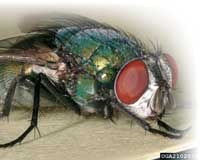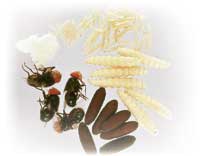Forensic entomology: activities for schools Teach article
Many of you were fascinated (and disgusted!) by the article about forensic entomology in our last issue. Paula Starbäck, the reviewer, suggested that it would be a fascinating activity for students, if only someone could find a way to avoid the terrible smell. We challenged you to come up with a…

Image courtesy of
insectimages.org / Joseph
Berger
Despite the smelly conditions to which adult blowflies are attracted and in which they lay their eggs, working with the larvae need not be an olfactory torment. Towards the end of the larval period, the maggots finish feeding on animal tissues and search for a suitable site to pupariate. It is this post-feeding stage that is sold as fishing bait in angling shops, and is suitable (not smelly) for use in classroom activities. They are easy to keep: they do not need food and can be kept for one to two weeks in a fridge before they start to pupariate.
Here are some ideas of how to use blowfly larvae to investigate the behaviour and physiology of blowflies. How do your results in the laboratory relate to the ecology of the insects?
Responses to light
Construct simple arenas with different levels of light (e.g. cover half the arena with a piece of card) and see how much time the larvae spend at the different light levels (they usually prefer the dark). What do they do in the dark areas; for example, do they change their speed of movement (slow down), or rate of turning (change direction more often) or do they only change direction at the light/dark edge, so as to stay in the dark?
Effects of temperature

(clockwise from bottom left):
adults, eggs, first instar
larvae, second instar larvae,
third instar larvae, puparia
containing pupae
Image courtesy of Martin Hall
How long does it take larvae to pupariate (become pupae) at different temperatures? You would need an incubator of some sort that could be set to different temperatures. Plot temperature against the time taken to pupariate. Note that the larvae might be at different ages when purchased, so you would need to compare different temperatures using larvae from the same batch, rather than buying one batch and testing it at one temperature and then buying another batch and testing it at another temperature.
This investigation could be extended by looking at the effects of temperature on time spent as pupae and, if a more complex dissection study were required, students could record the morphological changes in the pupa as metamorphosis proceeds (e.g. onset of segmentation, the first appearance of legs and wings, the first appearance of eyes, then body coloration and so forth). Do these occur at the same intervals in development (e.g. at 25%, 50% through the pupal period) at different temperatures?
Effects of substrate texture
How far do larvae migrate in different media? This can be measured by how long it takes them to pupariate. Test larvae with a hard surface and compare with larvae in sawdust and in sand/soil, both of which they can burrow into.
Effects of substrate moisture
Do larvae select soil with a different moisture content to burrow into? You could set up a chamber, offering larvae a choice of dry, damp and waterlogged soil to burrow into. Measure dampness by some easy system, e.g. volume of water per volume of soil.
Other influences
You could also measure what factors influence the length of time that the larvae spend wandering and burrowing, e.g. light, temperature, gradient, objects on the surface under which they can rest.
Available species
Different shops sell different species, but usually the largest larvae are Calliphora vomitoria (bluebottle fly), the intermediate sized ones are Lucilia sericata (greenbottle fly) and the smallest are Musca domestica (housefly). Different responses may be observed with the different species. A few could be reared to adulthood to facilitate identification.
Safety note
Students should take care when handling larvae to avoid contamination (the larvae have, after all, fed on decomposing animal tissues). Wear rubber gloves and wash hands afterwards with disinfectant soaps. Although teachers and students should not be complacent, the risks are low: after all, many millions of fly larvae are sold each year to anglers with no health and safety warnings.





